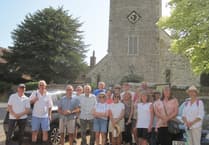IT’S A summer sport associated with manicured lawns flat as green tables, courteous behaviour by players dressed in smart white trousers or skirts – bowls has been played in England, and many other parts of the world, for centuries.
Since the dawn of civilisation, people have devised games with round objects and a form of bowls is known to have been played by Egyptians 5,000 years ago. It’s likely the Romans spread its popularity across Europe.
Hampshire can claim to be home of the world’s oldest surviving bowling green with what is now called Southampton Old Bowling Green, on the corner of Lower Canal Walk and Platform Road, in the ancient heart of the city close to the original dockside and High Street, which was first used in 1299.
The Hospital of “God’s House” was founded in 1185 for pilgrims who were going either to the shrine of St Swithun at Winchester or to Canterbury. The green adjoining the God’s House Hospital had been established during the reign of Richard I for the recreational use of the Warden.
The club which plays there now is believed to have been established in the 17th century because of the history of a competition known as the ‘Knighthood’. It is also the only club with a ‘Master” in charge, a title carried forward from the earliest of days.
Bowls continued to be associated with nobility rather than ordinary folk with Henry VIII being a keen player yet prohibiting his subjects from playing. However, his daughter, Elizabeth I, had reason to be grateful for a bowls game at Plymouth Hoe where Sir Francis Drake spied the approaching Spanish Armada, 430 years ago this summer, and finished his match before dealing with the enemy.
Charles II was another keen royal bowls player and he may well have used the green at the former White Hart in Petersfield when he stayed at the High Street inn while visiting his mistress Louise de Keroualle, when she was at Castle House in The Square.
The green extended behind the inn, now Winton House, towards the stream, and it is documented that the diarist Samuel Pepys, who stayed at the inn while en route between London and his duties in Portsmouth as Chief Secretary to the Admiralty, enjoyed bowling there.
It was the Victorians who formalised the structure of rules and organisation of lawn bowls clubs throughout Britain. With the establishment of local authorities, many of them built municipal parks with a range of facilities, especially tennis courts and bowling greens for genteel exercise.
With increasing leisure time, private members’ clubs were also thriving, such as Petersfield Bowling and Snooker Club, which was inaugurated in July 1908, and is firmly rooted at its site in St Peter’s Road in the centre of town.
Bowls remains popular in many communities in East Hampshire, such as Rogate, Headley, Liphook and Meon Valley, and residents of Clanfield are eagerly awaiting the opening of their new club this summer.




